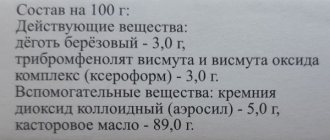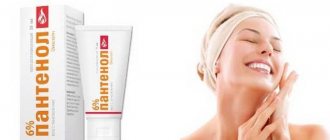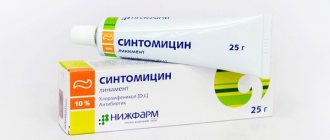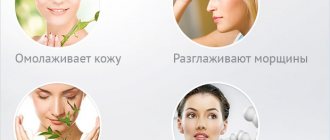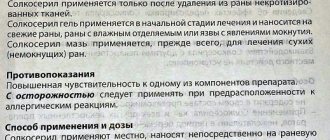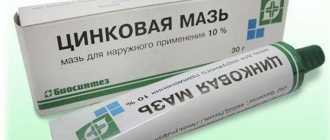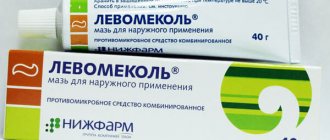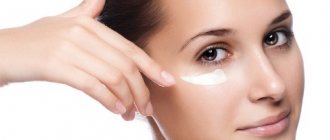Boils are a skin disease that is accompanied by purulent-necrotic processes. This disease causes painful cavities filled with pus to form. Most often they are formed as a result of inflammation of the hair follicles. The causative agents of the disease are staphylococci. The disease causes pain and aesthetic problems to a person. If the boil is not treated, the pus will poison the body and the person will develop symptoms characteristic of intoxication: chills, fever, headaches and others. You should not delay treatment, because there may be complications in the form of the development of diseases of the internal organs.
Levomekol, an affordable remedy for boils
In what cases is it prescribed
The ointment is used to treat:
- burns of II, III degree;
- necrosis;
- hemorrhoids;
- stomatitis and periodontal disease;
- bedsores;
- trophic ulcers;
- acne, boils and pimples;
- purulent otitis;
- rhinitis and sinusitis;
- frostbite;
- diseases of the genitourinary system.
The ointment is used after surgical operations on wounds obtained after opening ulcers, on calluses.
In what cases should the ointment be used?
The inflammatory process appears when staphylococci multiply intensively against the background of unfavorable conditions for the body. The process takes place in two stages:
- infiltrative – the appearance of inflammation in the form of a red tubercle with pain;
- purulent - ripening and breakthrough of boils.
Levomekol can be used at both stages of boil formation. The product penetrates into diseased tissues through the pores and begins to act:
- inhibits the growth of bacteria;
- removes necrotic masses in the form of pus, accelerates purulent formation;
- regenerates skin cells and tissues, heals the wound after opening;
- accelerates the removal of purulent masses through the hole in the drainage if the boil was removed surgically, and prevents new suppuration;
- improves the functioning of the immune system.
Composition of Levomekol ointment
The antibacterial properties of Levomekol make it an effective weapon for combating purulent inflammation and other skin diseases. In addition, the ointment accelerates the healing process and restores the structure of the epidermis. Levomekol is produced in tubes.
Active ingredients of the ointment:
- Levomycetin. This antibiotic has a wide spectrum of action. One of the most important features of this drug is its ability to effectively fight pathogens. It easily copes with infections such as E. coli, viruses, staphylococci and streptococci. The big plus is that viruses develop resistance to the active substances of this ointment very slowly.
- Methyluracil. The drug activates metabolic processes in cells, restores the skin, provides an anti-inflammatory effect and promotes wound healing. In addition, it affects the immune system, activates the production of interferon and improves immunity.
- Ethylene glycol. It is an additional agent and provides adsorbing properties.
Levomycetin is part of Levomekol
Additional components that promote good penetration and uniform distribution of active substances in skin tissues.
Each component included in the ointment enhances the effect of the other component. The active substances penetrate deep into the abscess and maintain antibacterial activity there.
How to treat a sore spot at home
You can get rid of a boil without seeing a doctor. Boils need to be treated continuously until the boil head is completely ripe.
It is recommended to carry out the procedure as follows:
- Treat the site of inflammation with medical alcohol, chlorhexidine or peroxide. To do this, apply a few drops of the product to a napkin or cotton pad, wipe the inflammation with light movements from the edge of the redness to the middle towards the core of the boil. Under no circumstances should you push or push!
- Heat the ointment to a temperature of 35 degrees. The consistency will become liquid, it will be more convenient to apply it to the skin or a napkin.
- Apply a thin layer of Levomekol to the inflamed skin, cover with a napkin, and apply a bandage.
- It is allowed to make a compress using gauze, bandage and ointment. Apply a thin loose layer of ointment to the boil. Don't rub! Cover the inflammation with several layers of gauze. Also secure with a bandage or adhesive bandage.
- The bandage must be changed 3 times a day, preferably at the same time. To do this, remove the bandage, remove the remaining Levomekol from the sore spot, disinfect, apply ointment, and fix the compress. Carry out manipulations until the wound is completely cleansed and healed. The usual course of treatment lasts 2–5 days depending on the inflammation.
Another way to treat the surface of a boil is without compression. Clean the wound of infection, apply ointment to the boil, rub it into the inflamed skin until dry. Movements should be performed carefully and very carefully so as not to increase pain.
With proper treatment, the inflammatory process will decrease, pain will go away, and the diameter of the redness will decrease. The abscess will break through in about 3 days. Then the ointment must be placed directly into the wound so that the pus comes out and the wound begins to scar.
If after all the procedures performed within 5 to 7 days, the boil remains and the situation has not improved, you should visit a professional dermatologist. The therapy will contain antibiotics, gels, and ointments in combination.
Methods of using Levomekol on wounds with pus and abscesses
Levomekol for pus is applied to the damaged area in different ways. Before using the medicine, you must take two important steps:
- The purulent-necrotic lesion should be treated with hydrogen peroxide. Instead, you can use other antiseptics such as Chlorhexidine, medical alcohol. Levomekol draws out the purulent contents and, in parallel, the infection spreads to the surrounding tissues. To disinfect the pathological area and neighboring areas, it is necessary to wipe them with disinfectants. When treating an abscess, it is not recommended to press it hard. Education hurts a lot. When pressed, the discomfort intensifies.
- Levomekol draws out purulent contents when it comes into contact with an infectious focus. After treating the pathological area, you need to decide how to apply local drugs. The effectiveness of the procedure depends on the correct method of applying the product to cleanse the wound of pus.
An antimicrobial agent in the form of a compress draws out the pathological fluid. To carry out the manipulation you will need gauze and a bandage. Levomekol is applied to the area with pus. Gauze is placed on top. It is fixed with a bandage. There is no need to rub in the ointment. The old bandage can be replaced with a new one after 8 hours. Before applying a compress to suck out the pus, the pathological focus is treated again with antiseptics.
The ointment draws out the resulting contents in a short course of use. Within three days, the abscess significantly decreases in size.
Feeling better, pain goes away. The specialist advises to continue applying the ointment. It draws out the remaining pus inside the source of infection.
Doctors recommend using another method to remove pus from the wound. The ointment can be applied and rubbed into the inflammatory area. Levomekol sucks out pus in 2-3 days. When the drug draws out the pathological contents, there is no need to stop its use. Under the influence of active substances, wound healing occurs faster.
Duration of treatment
Factors on which course therapy with Levomekol depends:
- Local and general immunity
. The inflammatory process begins against the background of weakened immunity. The better the functioning of the immune system, the faster the body will cope with the infection. The patient recovers after 5–7 days when treated with Levomekol. - Severity of the disease
. When one boil forms, the course of treatment ends in a short time. If staphylococci multiply in several places at the same time, furunculosis appears. The disease affects different parts of the body, painful purulent acne develops with intoxication syndrome, which the body does not cope well with. Treatment of furunculosis usually takes two to three weeks. - Chronic and acute diseases of other types
. If a patient suffers from diabetes, he has problems with the functioning of the circulatory system, and the reparative properties of the epidermis are reduced. In such cases, long-term treatment with ointment is prescribed, under the supervision of a doctor, with periodic blood tests.
When will it be effective and when will it not?
Boils occur in different parts of the body: on the face (including ears, nose), back, upper and lower extremities, groin, buttock, i.e. where the maximum number of sebaceous glands is located or where constant friction is observed (along with contamination of the skin).
A prerequisite for its formation is the presence of hair follicles. The development of a boil (or several) is provoked in most cases by a bacterium called Staphylococcus aureus.
Subcutaneous formation has 3 stages:
- Infiltrative. It is characterized by the occurrence of an inflammatory process in the area of the hair follicle. External manifestations are redness, the formation of a painful tubercle with a rod.
- Purulent. Develops in 2 stages. First, the formation of pus inside the boil is observed, then it breaks out (the abscess is cleared).
- Healing. Closing of the wound after a boil breaks out (with a large formation (from 1.5 cm) - scarring).
The ointment is effective at any stage.
It is necessary to refuse the remedy in the following cases:
- allergic reaction to the active substance or auxiliary components;
- children's age (up to three years);
- psoriasis, atopic dermatitis, skin fungus.
During pregnancy and breastfeeding - under the supervision of a medical specialist.
Side effects
An inexpensive product with an antibacterial effect contains quite effective active ingredients, but gives a minimum of unwanted reactions if the instructions for use are not followed.
The ointment causes allergies if the patient's body is sensitive to the substances of the drug. The reaction manifests itself on the skin in the form of burning, scratching (urticaria), the appearance of redness and blisters, and general weakness.
With an increased dosage, as a result of a long course of getting rid of boils, hyperemia and itching occur in the area of inflammation.
One of the rarest phenomena associated with the use of Levomekol - angioedema shock - is dangerous due to its symptoms. Shock causes shortness of breath, the face and neck begin to swell, and the patient may die if the ambulance on duty is not called in time.
In all cases, you should avoid applying the ointment and consult your doctor for advice and prescription of an antihistamine and subsequent treatment.
Levomekol for boils
The combined drug Levomekol, which contains an antibiotic and an immunostimulating component, is effective for the treatment of boils. It destroys pathogenic bacteria: gram-positive, gram-negative, spirochetes, chlamydia, staphylococcus, rickettsia, anaerobic, aerobic bacteria, strains resistant to penicillin antibiotics. They cause inflammation on the skin, called a boil.
Levomekol ointment is effective in the treatment of boils on the face, burns, purulent wounds, abrasions, bruises, swelling after injuries, trophic ulcers, stye on the eyelid. When treating boils, it has an anti-inflammatory, antiseptic, healing effect, and can easily draw out pus.
Thus, there is no need to wait 4-5 days for the boil to burst. Literally a few days after using Levomekol, only slight redness will remain from inflammation.
Composition and properties
Levomekol ointment includes 4 components:
- purified water is the basis of the drug;
- methyluracil stimulates the body's protective properties, enhances cellular regeneration, healing, and relieves inflammation;
- chloramphenicol is an antibiotic, an active component that destroys many types of pathogenic flora, when applied externally, it is not absorbed into the bloodstream;
- polyethylene oxide 400 and 1500 – excipient.
The properties of Leovmekol ointment allow the product to be used in a wide variety of branches of medicine:
- dehydrating ensures the removal of excess fluid;
- anti-inflammatory – relieves redness and inflammation;
- antiseptic – destroys pathogenic bacteria, strains, cocci;
- regeneration ensures rapid healing of the skin and mucous membranes;
- drawing out pus;
- immunostimulating has a positive effect on local immunity, increasing the protective functions of the epithelium.
Indications for use
Levomekol ointment is a universal medicine that is used in the treatment of such disorders:
- Dermatology: acne, boils, abscesses, swelling, infected, purulent wounds, burns of various degrees, cuts, insect bites, abscesses, bedsores, injuries, abrasions.
- Ophthalmology: external, internal stye, conjunctivitis.
- Surgery: postoperative sutures (to avoid suppuration and infection).
- In otolaryngology it has been used for otitis media and sinusitis.
- Gynecology: gonorrhea, dysbiosis, thrush, vaginosis, vaginitis, cervical erosion, salpingitis, colpitis, genital herpes.
- In proctology, there is a frequent use of ointment for hemorrhoidal cones (in complex therapy with agents that have an antithrombic effect).
Therapeutic effect
Getting on the boil, Levomekol destroys the bacteria that caused the development of the abscess. The ointment also envelops the abscess, drawing out pus from it and relieving inflammation. At the final stage, it promotes healing and restoration of the skin.
Levmekol has the following effects:
- Relieves burning sensation.
- Kills pathogenic microbes.
- Stimulates the protective properties of the skin.
- Heals the epidermis and mucous membranes.
- Has an anti-inflammatory effect.
- Strengthens metabolism.
Instructions for use
For boils, Levomekol ointment should be applied to a purulent, inflamed abscess in a thick layer. Cover the boil with a sterile cloth and bandage. Leave for 2-3 hours. Change the napkin twice a day.
After a few days, the inflammation and swelling will subside, the pus will come out and the healing stage will begin. Continue to apply the drug to the burst boil for another day.
Levomekol ointment can be used not only for boils. The medication is applied pointwise to acne and styes on the eyelid. In the form of tampons, the product is inserted vaginally and rectally. A tourniquet moistened with the drug is placed in the ear canal or nostrils. Apply bandages with Levomekol for wounds, burns, abrasions, trophic ulcers, and large areas of skin damage.
You can find out about the duration of the course from the instructions for using the ointment or from your doctor. Often it does not exceed 14 days due to the presence of an antibiotic.
Overdose and side effects
Levomekol is not recommended for use in quantities of more than 3 grams per day. Large wounds are not an exception.
No cases of drug overdose have been previously identified. In general, the product can be considered safe. When used externally, it is not absorbed into the bloodstream.
Rarely, side effects such as redness, burning, itching are possible. This may be caused by an allergic reaction to the component methyluracil.
special instructions
Levomekol ointment can be used in childhood, but not earlier than 3 years. During pregnancy, the product will not cause harm when used externally. Doctors may even prescribe medicated tampons if the risk to the fetus is greater than the harm to the pregnant woman.
Contraindications
Levomekol is a medical drug, so it has contraindications. The following categories of patients cannot treat boils or treat wounds after opening a boil:
- women in the first trimester of pregnancy during the development of fetal organs and the formation of the placenta;
- newborns and children under one year old, so as not to get intoxicated;
- people with individual intolerance to ointment elements;
- for fungal skin diseases such as psoriasis, eczema, etc.
Features of application
- Pregnant women should consult a doctor before using the ointment. He will decide whether it is worth using the drug to get rid of purulent formations or prescribing similar medications that can cope with the disease. For extensive purulent wounds, Levomekol is not recommended. It contains an antibiotic that can penetrate the blood and placenta if used in large dosages.
- Only a doctor can prescribe the product to nursing mothers if there are serious concerns about the mother’s health. To minimize the risk for the baby, you can transfer the newborn to artificial feeding during the treatment period.
- When serious purulent inflammation appears on the skin of the face, you need to seek help from a specialist. After the examination, the dermatologist will prescribe a comprehensive treatment that will not lead to the formation of unsightly scars on the face in case of improper treatment with ointment and will not allow the infection to spread into the deep layers of the skin and tissue.
- In severe cases of the disease, doctors resort to surgical removal of boils. In such cases, Levomekol is used after surgery to treat and scar the wound and prevent the formation of new suppurations.
Clinical picture
As a boil forms in the nose, the patient’s condition may be aggravated by the following symptoms:
- increase in body temperature to subfebrile;
- headache;
- general weakness against the background of growing intoxication (especially during the transition to the carbuncle stage).
Most often, boils appear in the vestibule of the nose, since it is in this area that hair growth is observed.
Transition of boils into carbuncles
They can also occur at the tip of the nose and in the area of the nasolabial triangle. Externally, tissue hyperemia is noticeable. On palpation, severe pain is diagnosed. Further development of inflammation leads to swelling of this area, which covers the upper lip and cheek. A few days after the first signs appear, an abscess with a yellow-white stem forms.
Precautionary measures
Levomekol is a local external remedy. It should be applied with caution.
- If the ointment gets into your eyes, they should be rinsed with water. If the medicine gets inside, the victim needs to rinse the stomach and give absorbent medicines.
- After treating the wound, you should wash your hands thoroughly with soap.
- You can treat the boil with ointment up to 4 times a day. An overdose of the drug has not been noted, however, the drug may cause an allergic reaction, and treatment will have to be interrupted.
- When treating inflammation with Levomekol, other medications should not be used.
- Course therapy can be carried out for up to 10 days. If further treatment is required, you should visit a doctor - only he can indicate further procedures. When using the ointment for a long time, patients should have their blood tested.
Analogues of the drug for the treatment of boils
Boils can be treated with various means. Depending on the principle of action, they are used at different stages of the disease.
When inflammation occurs, the affected area is lubricated with Tetracycline, Ichthyol ointment, Synthomycin, Baneocin, Bactroban or Oflocaine. The listed drugs help the rod mature and reduce pain.
After the boil has matured and broken through, Vishnevsky or Zinc ointment, Solcoseryl, or any product with Panthenol will be suitable. They will help remove the remaining pus, dissolve the compaction on the skin and help the wound heal.
